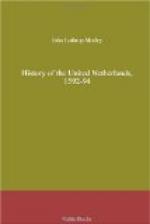Meantime it became necessary to follow up the St. Denis comedy with a still more exhilarating popular spectacle. The heretic had been purified, confessed, absolved. It was time for a consecration. But there was a difficulty. Although the fever of loyalty to the ancient house of Bourbon, now redeemed from its worship of the false gods, was spreading contagiously through the provinces; although all the white silk in Lyons had been cut into scarves and banners to celebrate the reconciliation of the candid king with mother Church; although that ancient city was ablaze with bonfires and illuminations, while its streets ran red, with blood no longer, but with wine; and although Madam League, so lately the object of fondest adoration, was now publicly burned in the effigy of a grizzly hag; yet Paris still held for that decrepit beldame, and closed its gates to the Bearnese.
The city of Rheims, too, had not acknowledged the former Huguenot, and it was at Rheims, in the church of St. Remy, that the Holy Bottle was preserved. With what chrism, by what prelate, should the consecration of Henry be performed? Five years before, the League had proposed in the estates of Blois to place among the fundamental laws of the kingdom that no king should be considered a legitimate sovereign whose head had not been anointed by the bishop at Rheims with oil from that holy bottle. But it was now decided that to ascribe a monopoly of sanctity to that prelate and to that bottle would be to make a schism in the Church.
Moreover it was discovered that there was a chrism in existence still more efficacious than the famous oil of St. Remy. One hundred and twelve years before the baptism of Clovis, St. Martin had accidentally tumbled down stairs, and lay desperately bruised and at the point of death. But, according to Sulpicius Severus, an angel had straightway descended from heaven, and with a miraculous balsam had anointed the contusions of the saint, who next day felt no farther inconveniences from his fall. The balsam had ever since been preserved in the church of Marmoutier near Tours. Here, then, was the most potent of unguents brought directly from heaven. To mix a portion thereof with the chrism of consecration was clearly more judicious than to make use of the holy bottle, especially as the holy bottle was not within reach. The monks of Marmoutier consented to lend the sacred phial containing the famous oil of St. Martin for the grand occasion of the royal consecration.
Accompanied by a strong military escort provided by Giles de Souvri, governor of Touraine, a deputation of friars brought the phial to Chartres, where the consecration was to take place. Prayers were offered up, without ceasing, in the monastery during their absence that no mishap should befal the sacred treasure. When the monks arrived at Chartres, four young barons of the first nobility were assigned to them as hostages for the safe restoration of the phial, which was then borne in triumph to the cathedral, the streets through which it was carried being covered with tapestry. There was a great ceremony, a splendid consecration; six bishops, with mitres on their heads and in gala robes, officiating; after which the king knelt before the altar and took the customary oath.




